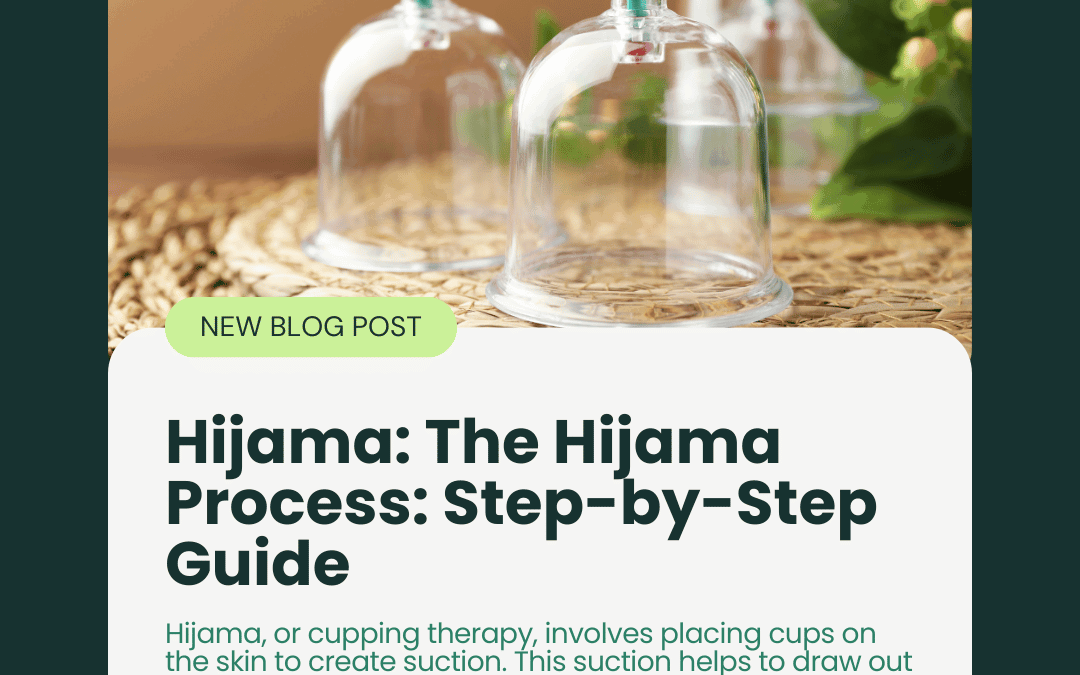Hijama
What is Hijama?
Hijama, or cupping therapy, involves placing cups on the skin to create suction. This suction helps to draw out toxins, improve blood circulation, and stimulate the body’s natural healing processes. It is a holistic treatment that can address a variety of health concerns, from chronic pain and inflammation to stress and fatigue.

Benefits of Hijama
1. Detoxification: Hijama helps in removing toxins from the body by stimulating the lymphatic system and improving blood flow. This detoxification process can enhance your overall health and vitality.
2. Pain Relief: Whether you suffer from chronic back pain, migraines, or muscle tension, Hijama can provide significant relief. The suction created by the cups helps to reduce inflammation and ease muscle tension.
3. Improved Circulation: By drawing blood to the affected area, Hijama promotes better circulation. Improved blood flow can aid in faster recovery from injuries and enhance your body’s overall function.
4. Stress Reduction: The relaxing effect of Hijama therapy can help reduce stress and anxiety. The treatment encourages the release of endorphins, which are natural mood elevators, helping you feel more relaxed and at ease.
5. Skin Health: Hijama can also improve skin health by increasing blood flow and stimulating the release of toxins. It can help with conditions such as acne, eczema, and other skin disorders.
The Hijama Process: Step-by-Step Guide
Initial Consultation
1. Health Assessment: Your journey begins with a thorough health assessment. Our practitioner will discuss your medical history, current health concerns, and specific goals for Hijama therapy. This helps us create a personalized treatment plan tailored to your needs.
2. Explanation and Consent: We will explain the Hijama process in detail, addressing any questions or concerns you might have. Once you are comfortable and informed, you will be asked to sign a consent form.
Preparation
3. Site Selection: Based on your health assessment, the practitioner will identify specific points on your body where the cups will be placed. These points are typically on the back, but they can also be on other areas such as the legs, abdomen, or shoulders, depending on your condition.
4. Hygiene Protocol: We adhere to strict hygiene standards. The chosen sites will be cleaned with antiseptic wipes to prevent infection. Our practitioners wear gloves, and all equipment is sterilized or disposable.
The Hijama Procedure
5. Dry Cupping: The session often begins with dry cupping. A small flame is briefly placed inside the cup to create suction, and the cup is then placed on the skin. The negative pressure created by the suction draws the skin and superficial muscles into the cup. This step helps to stimulate blood flow and prepare the area for wet cupping.
6. Wet Cupping: After a few minutes, the cups are removed, and tiny, superficial incisions are made on the skin using a sterile blade. These incisions are very small and shallow, ensuring minimal discomfort. The cups are then reapplied to the same areas to create suction again, which helps draw out a small amount of blood along with toxins and impurities.
7. Duration: The cups are typically left in place for 5-15 minutes during each phase of the process. The entire Hijama session usually lasts about 30-60 minutes, depending on the number of points being treated and your specific needs.
Post-Treatment Care
8. Cleaning and Dressing: After the cups are removed, the treated areas are cleaned with antiseptic to prevent infection. A soothing ointment is applied to promote healing, and the sites are covered with sterile bandages.
9. Aftercare Instructions: You will receive detailed aftercare instructions to ensure optimal healing and results. This may include advice on keeping the area clean, avoiding strenuous activities for a day or two, and staying hydrated.
10. Follow-Up: Our practitioner may recommend follow-up sessions based on your health goals and response to the treatment. Regular sessions can help maintain the benefits of Hijama and support your overall well-being.
Understanding the Side Effects of Hijama (Cupping Therapy)
Hijama, or cupping therapy, is generally considered a safe and effective treatment when performed by a trained professional. However, as with any medical procedure, there are potential side effects and risks. It’s important to be informed about these so you can make a well-rounded decision regarding your health care.
Common Side Effects
1. Skin Discoloration: One of the most noticeable side effects of Hijama is the circular marks left on the skin where the cups were placed. These marks, which can range from light red to deep purple, are caused by the suction pulling blood to the surface. They typically fade within a few days to a couple of weeks.
2. Mild Discomfort: You might experience mild discomfort or a slight stinging sensation during and after the procedure, especially if you undergo wet cupping. The small incisions made during wet cupping can cause a bit of soreness, similar to a superficial cut.
3. Lightheadedness: Some people may feel lightheaded or dizzy immediately after the treatment, especially if they had multiple cups applied or if the session was lengthy. It’s advisable to rest for a few minutes before standing up to avoid dizziness.
Less Common Side Effects
4. Skin Infections: Though rare, there is a risk of skin infections if the procedure is not done under sterile conditions. To minimize this risk, ensure that the practitioner uses sterilized equipment and follows strict hygiene protocols.
5. Scarring: While uncommon, there is a possibility of minor scarring, particularly if the incisions are deeper than necessary or if the skin takes longer to heal.
6. Bruising and Hematoma: Bruising is common due to the suction effect, but in some cases, a more significant hematoma (a solid swelling of clotted blood within the tissues) can develop if a blood vessel is damaged during the procedure. This typically resolves on its own but can be uncomfortable.
7. Allergic Reactions: Some individuals may have an allergic reaction to the oils or creams used during the treatment. It’s important to inform your practitioner of any known allergies beforehand.
Rare Side Effects
8. Nausea and Fatigue: A small number of people might experience nausea or fatigue following the procedure. This is usually temporary and resolves with rest and hydration.
9. Headaches: In rare cases, Hijama can trigger headaches, particularly if the treatment is focused on the neck or head area. This is typically short-lived and can be managed with over-the-counter pain relievers.
Minimizing Risks
To minimize the risks associated with Hijama, consider the following:
- Choose a Qualified Practitioner: Ensure that the practitioner is licensed, experienced, and follows strict hygiene practices.
- Pre-Treatment Consultation: Have a thorough consultation to discuss your medical history, current health status, and any concerns you may have.
- Follow Aftercare Instructions: Adhere to the aftercare instructions provided by your practitioner to promote healing and prevent infections.
- Stay Hydrated and Rest: Drink plenty of water and get adequate rest after your session to help your body recover.
Conclusion
While Hijama is generally safe and offers numerous health benefits, it’s important to be aware of the potential side effects, we prioritize your safety and well-being, ensuring that all procedures are performed under the highest standards of care. If you have any concerns or questions about Hijama therapy, please feel free to contact us. We’re here to help you achieve optimal health in the safest way possible.
